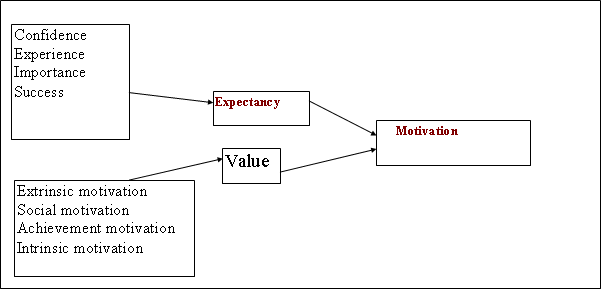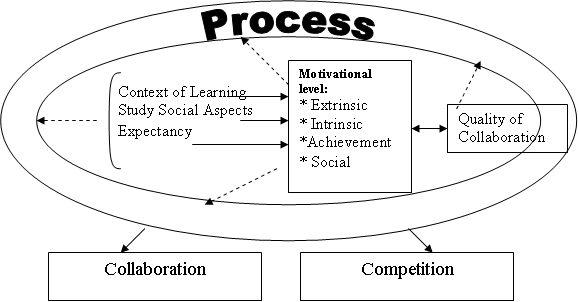Learning Context
The learning strategies students adopt are influenced by a number of factors. These factors can be analysed using Ramsden’s (1992) model concerning learning context. Ramsden (1992) suggests that the learning outcome is influenced by a number of factors. Students’ previous learning experiences and context of learning such as teaching methods, curriculum and assessment influence students’ general orientation to studying i.e. seeking meaning (deep approach) or reproducing (surface approach) and the perception of the demands of specific tasks. These affect the approach to learning and the learning outcome. The model can be seen in Figure 1.

Figure 1: Ramsden’s model about learning context (1992:83)
Extrinsic and intrinsic motivation in context
The expectancy-value theory of motivation
Two factors make students want to learn something (Feather 1982).
It has to be important; it must have some value to the learner
It must be possible to do the learning task; the learner has to expect success.
This common-sense theory of why students do or do not want to learn is called the expectancy-value theory of motivation. It argues that if anyone is to engage in an activity, he or she both needs to value the outcome and expect success in achieving it (Feather 1982). If either one is not present, motivated activity does not occur. Expectancy-value theory is particularly relevant in the early stages of learning before interest has developed to carry continued engagement along with it (Biggs 1999). However in the context of this course it is applicable in terms of examining why students took a collaborative approach, and others a more competitive approach.
Expectancy
What then makes students expect to succeed or to fail? Success can, for instance, be attributed to the teacher, individual ability and effort. If a student has a history of successful engagement with a subject that is personally meaningful, the student builds up the knowledge base needed for deep learning and develops the expectations that give confidence for future success. This is known as feelings of self-efficacy and ‘ownership’ (‘I can do this; this is my thing’). The most direct way expectations of success are instilled is on the basis of previous success but only if the conditions that are believed to lead to success remain unchanged.
These attributions of success are also sensitive to teacher feedback. By giving students feedback about the process, ‘This is what you did, this is what you might have done, this is how to get a better result’ as in criterion-referenced assessment, belief in future success is encouraged. In teaching it is important to bear in mind how you help instil expectations of success (or failure) in students.
Value of task
In order to come to an understanding of why collaboration in learning seems to be successful for some people and not for others the next step is to look at what makes a task valuable to students. The answer is to make their work important to them. Work can be important in various ways, each one producing a different kind of motivation - depending on the context. The forms of motivation are; extrinsic motivation - what the outcome produces e.g. sitting an exam or writing an essay - this can be rewarded or punished by pass or failure; intrinsic motivation, which involves enjoying the process of doing a task; achievement motivation, which gives an opportunity for ego-enhancement; and social motivation which is concerned with what people value.
Extrinsic and achievement motivation
The quality of learning under extrinsic conditions is usually low - particularly if it is negative reinforcement such as failure. It also tends to encourage students to adopt a surface approach. We would consider that surface approaches to learning are less conducive to producing high levels of negotiation. Assessment often acts as an extrinsic motivator (Lepper 1988), encouraging students to focus their ways of learning in an appropriate way in relation to what is to be assessed.
Social and Intrinsic motivation
Students learn in order to please people whose opinions are important to them. If the process of studying or the fruits of a good education are highly valued by other people important to the student, education may take on an intrinsic importance to the student. We can usually trace the beginning of our interest in something to someone else who exhibited that interest to us; we wish to be like him or her (Feather 1982). This is the process called ‘modelling’. It can therefore be of great value when teachers who love their subject show their enthusiasm and inspire students. This is why tutors in an Internet based course have an important role in ‘setting the atmosphere’ by being encouraging, showing interest and asking questions in a way that is not inhibiting. Intrinsic motivation stimulates students to learn because they are interested in the task or activity itself, and in that way is process oriented. For intrinsically motivated students, the point is to travel rather than arrive and this motivation can bring a deep approach to learning. We have summarised the expectancy-value theory of motivation in diagrammatic form as shown in Figure 2 below.

Figure 2: Expectancy-value theory of motivation
The role of assessment in collaboration
How can one create value in a task if it is not already considered to be valuable by the students? A common cry is that students will not spend time learning a topic if they think it is not going to be assessed. Therefore, most topics are assessed. This is, however, a double-edged strategy because if that is the topic’s only value, it is an excellent way of devaluing it. As said earlier, assessment often acts as an extrinsic motivator (Lepper 1988), encouraging students to focus their ways of learning in an appropriate way in relation to what is to be assessed. Thus, it is a problem if student-activating methods of teaching are introduced without consequently changing the methods of assessment.
Approaches to learning
Students’ approaches to learning have been categorised in a number of ways. Marton and Säljö (1976) differed between deep and surface level learning, where deep refers to a meaning seeking approach, with the intention to understand, and surface a reproducing approach, with the intention only to complete task requirements. Later, the achievement (or strategic) approach, aiming at achieving high grades, was added by Entwistle and Ramsden (1983). However, these categories of approaches to learning all stem from a situation where students work individually. Recent research (Lonka et al. 2001) indicates that the deep approach to learning may be re-evaluated in new, collaborative learning environments. Instead, a collaborative-constructivist view may be viewed as important learning orientation (Lonka et al. 2001).
DESIGN AND ASSESSMENT METHODS: NEW TECHNOLOGY AND LIFELONG LEARNING MODULE
Design
The module is 18 weeks in duration and is divided into two distinct phases presenting opportunities for both co-operation and collaboration. The first phase of the module (Term II) is concerned with co-operative leaning and consists of one large discussion and two parallel group discussions. Within these groups participants explore a topic through discussion and use the knowledge building process as a way of furthering individual learning.
During the second phase of the module (Term III) participants work together in a more concentrated way; participants form into smaller groups (two or three people), concentrate on a topic of mutual interest and produce a collaborative paper. Within this phase a combination of individual and group based assessment is used.
Virtual Learning Environment
Electronic mail was the principal delivery mechanism for the first year of the module but in the second year a bulletin board system called Webboard was implemented. In the second year the course team made changes to the communication medium combined with minor changes to the course structure, timing and to the assessment requirements. The changes made to the module, combined with the change in delivery mechanism, appeared to impact on the quality of the collaborative experience in the second year.
Assessment
Co-operative activities (Term II): Year 1 and II
Participants' were required to submit five short papers (500 words each) at strategic points during the module which together amount to 50% of each student's individual mark. The papers were submitted at the beginning and at the end of each of the two discussions with the fifth paper submitted on completion of the module. The first half of the course is concerned with individual assessment with the emphasis shifting to the inclusion of a small percentage of collaborative assessment in the second half. The assessment for the discussions (term I) - the co-operative phase of the course - remained virtually unchanged over the two years, however, small changes to the collaborative assessment during the second year were made in order to help orient students towards collaboration.
Collaborative activities (Term III):Year I
During the first year the collaborative study project amounted to 40% of an individual's total mark, the remaining 10% was a collaborative mark which was awarded to each group based on a presentation of their group project. The course team asked participants to work together as a team to brainstorm ideas relating to their chosen topic and to flesh out related yet separate strands for each participant to consider. Team members were then asked to disseminate the results of their discussions in the form of an individual paper.
During the first year group members engaged in some initial discussion relating to the topic, agreed on the particular slant each was to take but then worked more or less alone until the project deadline. Since groups ended up with three papers instead of one it was more difficult to conduct a group led discussion based on a group's findings; the papers were too diverse for a joint discussion to work successfully in the allocated time (one week). The group led discussion therefore had to be abandoned which meant that the collaborative study project amounted to 50% of the total course mark and was awarded as an individual mark. This meant that, in reality, the first year of the module reflected no change in assessment practice despite attempts to allow course participants to work collaboratively.
Collaborative activities (Term III): Year II
For the second year of the module the course team made changes to both the practice of assessment and to the structure of the collaborative exercise in order to orient students towards collaboration rather than individual working. The collaborative study project was divided into two stages the first being the 'individual stage' and the second being the 'collaborative stage'.
During the individual stage participants were asked to work in much the same way as they did during the first year; brainstorming ideas and fleshing out the resulting strands which participants individually wished to pursue. Students were asked to work closely with one another to ensure that their individual pieces of work related to one another. After a period of four weeks participants submitted their individual pieces of work to the Webboard (approximately 2500 words) and were awarded an individual mark amounting to 30% of the final total. During the second stage of the project team members integrated the individual papers into one final paper. This second stage amounted to 20% of the final total and marks were awarded to the group for their final efforts.
Experience and outcomes
The new structure alongside the change in assessment practice for the collaborative project (year 2) produced an interesting array of approaches to the final paper. The following discussion examines the approach each group took to arrive at the group paper and also reflects some of the impressions of those who were involved.
'Core - amalgamation'
Within this group a 'core paper' was used with the other two papers being amalgamated into the main paper. It is, perhaps, no co-incidence that the person who opted to function as the group ‘scribe' selected his paper as the basis for the final paper.
